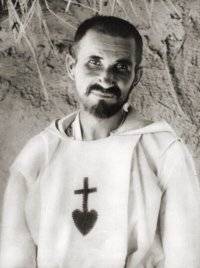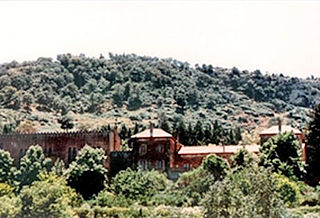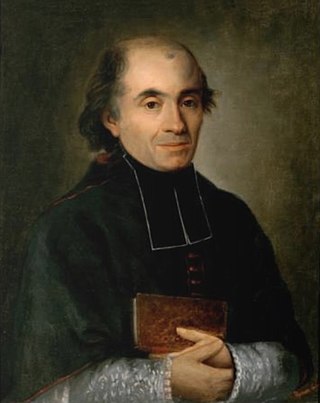Related Research Articles

During the Spanish Civil War Catholic people faced persecution from the Republican faction of the war, in part due to their support of the nationalists and the recently abolished monarchy. The Catholic Church venerates them as martyrs. More than 6,800 clerics and other Catholic people were killed in what has been dubbed the Red Terror. As of October 2022, 2,107 Spanish martyrs have been beatified; 11 of them being canonized. For some 2,000 additional martyrs, the beatification process is underway

On the night of 26–27 March 1996, seven monks of the Trappist order from the Our Lady of the Atlas Abbey of Tibhirine near Médéa, Algeria, were kidnapped during the Algerian Civil War. They were held for two months, and found dead in late May 1996. The circumstances of their kidnapping and death remain controversial; the Armed Islamic Group claimed responsibility for both, but in 2009, retired General François Buchwalter reported that the monks were killed by the Algerian army.

Henri Antoine Marie Teissier was a French-Algerian Catholic Bishop of Algiers and Archbishop Emeritus of Algiers.
Pierre-Lucien Claverie, OP was a French Catholic prelate who was a professed member from the Order of Preachers and served as the Bishop of Oran from 1981 until his murder in 1996 by Islamic extremists.

The Abbey of Our Lady of Atlas is a Catholic monastery of Trappists, inaugurated on March 7, 1938, in Tibhirine, close to Médéa, in Algeria.

Pierre Bonhomme was a French Roman Catholic priest who exercised his pastoral mission in Cahors. He went on to establish the new religious congregation known as the Sisters of Our Lady of Calvary of Gramat.
Charles-Marie Christian de Chergé, O.C.S.O, was a French Roman Catholic Cistercian monk. He was one of the seven monks from the Abbey of Our Lady of Atlas in Tibhirine, Algeria, kidnapped and believed to have been later killed by Islamists. He was beatified with eighteen others, the Martyrs of Algeria, on December 9, 2018.

The Martyrs of Laos are seventeen Catholic priests and professed religious as well as one lay young man venerated as martyrs killed in Laos between 1954 and 1970 of the First and Second Indochina Wars during a period of anti-religious sentiment under the Pathet Lao Theravada Buddhist-communist political movement.

The Martyrs of Albania were a collective group of 38 individuals killed during the Communist regime in Albania from 1945 until 1974. All were born at various times between 1874 and 1935; the group included Albanians and Italians as well as one German. Each of these individuals, apart from four, were part of the religious life as either priests or religious and served as either missionaries or educators with a great deal spending their educational formation in Italian and Austrian cities.
Romano Bottegal was an Italian Roman Catholic priest and Trappist monk. Bottegal joined his order in the 1940s and lived as a hermit in Lebanon. He studied in Belluno and Rome before he was ordained as a priest and following this lived in Rome among his peers; he moved to Lebanon to oversee a new project there but was forced to return to Rome after it failed. But he was later granted permission to return there in order to live as a hermit where he remained in seclusion until his death.

Honorat Koźmiński, born Florentyn Wacław Jan Stefan Koźmiński, was a Polish priest and professed member from the Order of Friars Minor Capuchin who went on to establish sixteen religious congregations. He was a teacher before reinvigorating clandestine religious orders that the Russian Empire had suppressed during their occupation of Poland. He collaborated with a number of individuals in this venture and he publicised the Third Order of Saint Francis to people.

Salvador Montes de Oca (21 October 1895 – 10 September 1944) – in religious Bernard(o) – was a Venezuelan Roman Catholic prelate and novice from the Carthusians who served as the Bishop of Valencia from 1927 until his resignation in 1934. Montes had limited pastoral experience before being appointed as a bishop but had served for a period as a spiritual director and after his appointment was known for upholding traditional teachings. But his defense of tradition on marriage and divorce led to his expulsion from Venezuela on the charge of inciting "rebellion" to which he was forced to reside at Port of Spain in Trinidad and Tobago from late 1929 until late 1931.
Christophe Lebreton OCSO was a French Trappist monk. He was one of seven Trappist monks from the Our Lady of the Atlas Abbey of Tibhirine near Médéa, Algeria who were kidnapped and killed during the Algerian Civil War. He was recognized as a martyr by Pope Francis in January 2018, and proclaimed Blessed on December 8, 2018 in Oran, Algeria, along with the other martyrs of Algeria. His writings, published after his death, reveal his poetry and spiritual depth. The murder of the monks of Tibhirine gained widespread attention in the prize-winning film Of Gods and Men.
Odette Prévost was a French Roman Catholic nun, who was working as a teacher and a librarian when she was killed in Algiers en route to Mass. She is recognized as a martyr and was proclaimed blessed on 8 December 2018.

The Congregation of the Missionary Sisters of Our Lady of the Apostles is a Roman Catholic religious congregation, founded in 1876 in Lyon, France, by Father Augustin Planque, the first Superior General of the Society of African Missions.
Esther Paniagua Alonso was a Spanish nun, born in Izagre, on June 7, 1949, daughter of Nicasio Paniagua and Dolores Alonso, and member of the congregation of Augustinian missionaries. As a nurse, she was sent to Algeria where she worked in Bab El Oued, in Algiers. She was murdered in Algiers on October 23, 1994 with sister Caridad Álvarez Martín. On January 27, 2018, Pope Francis recognized the martyrdom of Esther Paniagua Alonso among the martyrs of Algeria and authorized the signing of the beatification decree. She was proclaimed blessed on December 8, 2018.
Jean-Pierre Schumacher was a French Trappist monk.

Pedro Ortiz de Zárate was an Argentine Roman Catholic priest and Giovanni Antonio Solinas was an Italian Roman Catholic priest and a professed member of the Society of Jesus. Zárate served in a local municipal role before he was married and had two children. He was widowed and decided to enter the priesthood once his two sons were old enough to handle the change; he was a noted preacher and envisioned himself as one that would convert and preach amongst the local Argentine native tribes. Solinas left for the Argentine missions alongside three companions and moved from place to place before he settled in the Salta province. Both priests were slain after two tribes of natives decided to deceive them to preach and work in their village before ambushing and killing both priests; eighteen others were slain alongside them and their bodies left to be discovered as the assailants fled in fear of Spanish forces that were not too far from their position.
References
- 1 2 3 Jeanne Kun (October 2011). "The Trappist Martyrs of Algiers". Living Bulwark. Retrieved 9 November 2017.[ permanent dead link ]
- 1 2 3 4 5 6 7 8 9 10 11 12 13 14 15 16 17 18 "The Blood of Love, the Martyrs of Algeria 1994-1996". Africa Mission. Archived from the original on 16 November 2017. Retrieved 9 November 2017.
- ↑ Bruce Crumley (16 July 2009). "Could Seven Dead Monks Upset President Nicolas Sarkozy's Bold Plans to Remake France's Legal System?". TIME magazine. Retrieved 9 November 2017.
- 1 2 3 4 5 6 7 8 "Sainthood Cause of the Martyrs of Algeria, opened". Communio. 3 December 2013. Retrieved 9 November 2017.[ permanent dead link ]
- ↑ Jean-Pierre Schumacher. "The Seven Brothers of Tibhirine". Trappists. Archived from the original on 9 November 2017. Retrieved 9 November 2017.
- ↑ "Un square en souvenir des moines de Tibhirine". Le Parisien (in French). 29 May 2016. Retrieved 16 April 2018.
- ↑ Bernadelli, Giorgio (15 May 2016). "Square near Bataclan to be named after Tibhirine monks". Vatican Insider. Retrieved 9 November 2017.
- ↑ Demangeat, Isabelle (30 May 2016). "À Paris, un jardin porte le nom des moines de Tibhirine". La Croix (in French). Retrieved 16 April 2018.
- ↑ Claire Lesegretain (30 March 2016). "One step closer to beatification for the martyrs of Algeria". La Croix. Retrieved 9 November 2017.
- ↑ Nicholas Senèze (4 September 2017). "Will bishop 'martyr' from Algeria be beatified?". La Croix. Retrieved 9 November 2017.
- ↑ "Promulgation of Decrees of the Congregation for the Causes of Saints, 27.01.2018" (Press release). Holy See Press Office. 27 January 2018. Retrieved 16 April 2018.
- ↑ "Algerian martyrs to be beatified in Oran this year". Catholic News Agency. 11 April 2018. Retrieved 16 April 2018.